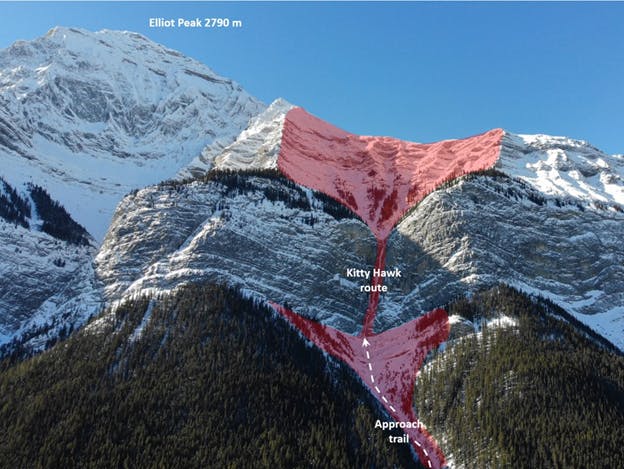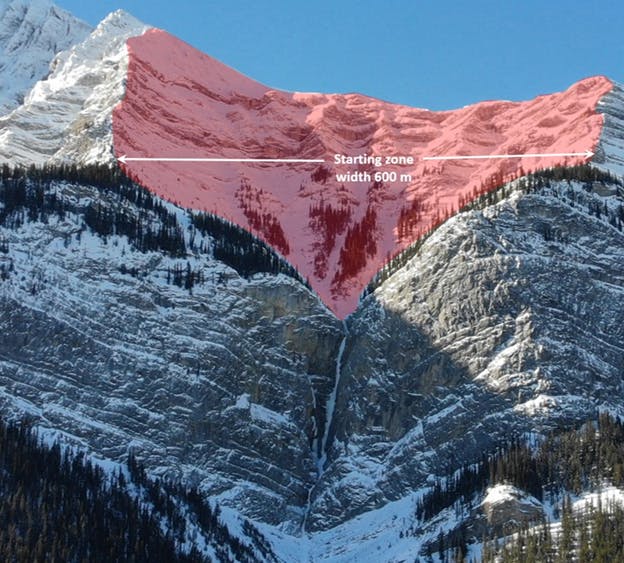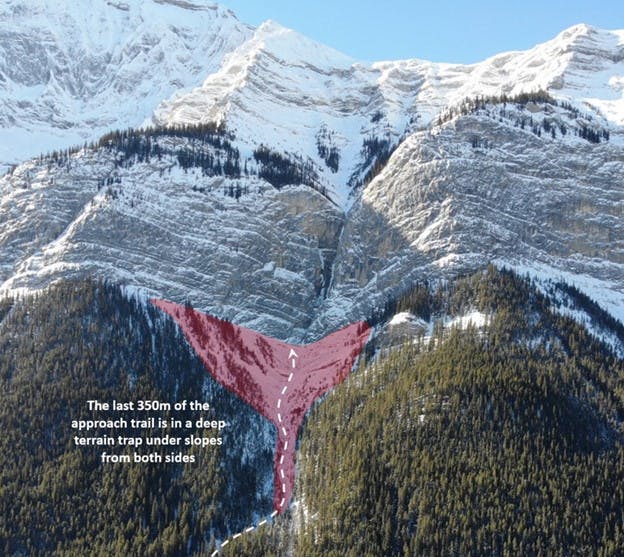Kitty Hawk
200 m, WI 5
ATES 4 (Extreme)

Kitty Hawk is an excellent climb located on Elliot Peak, 40 km east of the Saskatchewan River Crossing on Highway 11 (David Thompson Highway). However, Kitty Hawk is threatened by significant avalanche danger, both during the approach and from overhead slopes while on the climb. There are many stories of climbers being involved in avalanches here, and people have even been swept down over the approach pitches and onto the slopes below. The climb is located inside a narrow gully and all avalanches starting from above funnel through here.
Consequently, this climb requires low avalanche danger and a cool or cloudy day, as the upper slopes are exposed to the morning sun.
Popularity
- 47 people completed this survey
- 42% climbed Kitty Hawk once
- 43% climbed it 6-12 times
- 15% climbed it over 6 times
Avalanche Frequency
- 72% have seen avalanche debris on the climb or the approach
- 28% have not seen any avalanche debris
Avalanche Runout
- 48% saw avalanche debris on the approach
- 90% saw debris at the base of the climb or lower
- 26% saw debris between the pitches
- 10% saw debris above the last pitch
Notes on Avalanche Debris
- Avalanche debris can be several meters deep. Many people reported seeing debris all the way past the base of the climb.
- Many noted debris on the gully below the approach and between the approach and first few pitches. One person noted that they’ve frequently seen the approach ice covered by avalanche debris.
- Others described the debris along the full runout, 500 m below the route.
- One person wrote: “In the 2010s (unsure of the exact year), a large slide ran about 500 m or so below the route and took out mature timber. Most years the avalanche debris stops shortly below the base of the approach gully.”

Reported Avalanches and Incidents
- We went to climb Kitty Hawk on a snowy, calm day in late March. When a few small sluffs came down from the sidewalls, my partner insisted we bail. When I returned two days later, avalanche debris extended into the treeline, 400 m or more from the base of the climb. The approach gully that we had just ascended two days prior was now overflowing and filled to the brim for most of its length, making it impossible to tell where the gully was.
- I climbed the first pitch (or second if you break it up) to the overhanging shelter cliff. As soon as my guest arrived, I heard what sounded like a freight train and a size 2.5 to 3 avalanche went roaring above our heads. We rapped fast and at the base of the ice we waited for the second avalanche wave, which I had a feeling was going to happen. Ten minutes later, another size 2.5 to 3 avalanche came roaring over us.
- I've witnessed one large slide from the highway (likely size 2-3, accompanied by a huge powder cloud) triggered by the wind. Additionally, I’ve also witnessed a couple of smaller size 1 avalanches containing rocks while climbing the first pitch on a day that was too warm and sunny. After that, we decided to bail.
- It slid the day after our attempt. We decided to bail the day before due to high winds and new snow, just as we were preparing for the steeper sections of the climb.
- We were approaching the route as our plan C. While approaching, we noticed a bit of adjacent sluffing which was enough to cause us to cancel our attempt and find a safe vantage point to observe Kitty Hawk. We waited for the avalanche cycle to pass over the route. We didn’t have to wait very long and saw two or three avalanches blow over the route.
- As we were descending, an unexpected storm hit, filling the slot canyon at the base with unconsolidated snow from all of the sluffing. The snow reached waist to chest depth, and I found myself partially buried by a large sluff right at the base.
Some notable incidents include:
- March 10, 2018. When climbing the final pitch of Kitty Hawk around 9-10 am, my partner and I were hit by a naturally triggered avalanche, likely triggered by rapid warming/solar radiation. The start zone was determined to be in an upper bowl far above the final pitch, which subsequently triggered the slope just above the final pitch. The leader had securely positioned themselves off to the side, away from the pitch, anchored to a tree. However, the second climber was struck, as were two climbers from another party descending ‘Unicorn’. One of them, unroped and crossing towards a rappel station, was swept 200-300 meters down the fan. Fortunately, this climber was found unburied on the surface with significant but non-life-threatening injuries. Our group promptly alerted the Parks and self-evacuated to the road, where we were met by emergency medical services. After the incident, I flew over to inspect the bowl and crown line before entering the runout. It was evident that multiple interconnected start zones were contributing to the avalanche.
- We climbed Kitty Hawk during the 2023-24 season on a bluebird day. We walked up on rocks. The forecast called for some snowfall but nothing significant. However, while we were on the WI5 pitch, it started snowing at S3 intensity. We finished the pitch and spindrift started coming down on top of us. Nothing huge, however, it quickly accumulated like a flash flood in a canyon. Within moments, what was once rocky terrain transformed into five feet of snow. The main concern was the area around the mouth of the climb. When we reached the entrance, the face on lookers' left was shedding off size 1 dry loose avalanches, likely one every 30 seconds or so, obscuring the trail. Fortunately, everything worked out, but in a 30-minute timeframe, things got real. Once we reached the Saskatchewan Crossing, the storm had passed, and the skies cleared.

Contributing Factors in Order of Significance
- 63% winds
- 56% new snow
- 44% warming and solar radiation

Additional Notes from the Community
- The gully at the base is a nasty terrain trap.
- The east-facing bowl above the climb heats up very early in the day. Regardless of how early you start or how good the freeze is, it’s virtually impossible to avoid the daytime heating on sunny days with this aspect.
- Kitty Hawk is not within an avalanche forecast area and DTH experiences a different weather pattern, making it hard to assess conditions.
- There are many stories of avalanche incidents on this route. Some years back, an individual got flushed out the bottom and lost their ice tools. I remember this because they pinned a sign on a tree asking for them back if found. Additionally, I've opted to approach the final section from the climbers' left side on several occasions to mitigate exposure in the last approach gully under the large slopes. While effective, you have to cross several steep avalanche-prone gullies and then cross the open slope directly under the cliff to reach the base.